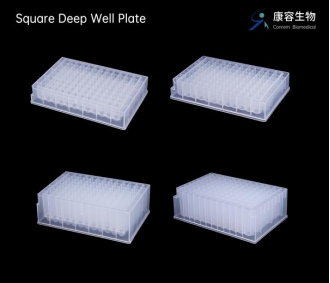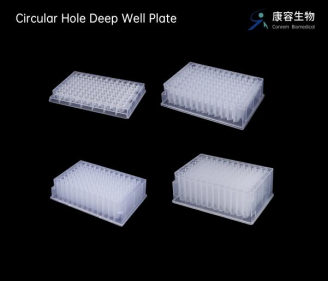Copyright © 2021 Suzhou Cotaus Biomedical Technology Co. Ltd. All rights reserved. Site Map Powered by 
Deep-well plate is one of the commonly used laboratory consumables and is mostly used for long-term storage of various active agents, DNA/RNA detection, nucleic acid extraction, antibody titer inspection, etc. In recent years, due to the new crown epidemic, the demand for nucleic acid detection has skyrocketed. As one of the main consumables in the nucleic acid detection process, deep-well plates are widely used in various testing institutions and laboratories.
1. According to the number of holes, the more common ones can be divided into 96-well plates, 384-well plates, and 96-well I-shaped plates.
2. According to the hole type, the 96-well plate can be mainly divided into round hole type and square hole type. The 384-well plates are all square wells.
3. According to the shape of the bottom of the hole, there are two common types: U-shaped and V-shaped.

It can replace the conventional 1.5ml centrifuge tube to store samples, and the storage is neat, space-saving, large storage capacity, and can withstand a -80 ℃ refrigerator. Therefore, it is also called a storage block.
It can be combined with a discharge gun, high-throughput automatic liquid manipulation instruments and software to achieve high-throughput manipulation of biological samples, such as protein precipitation and liquid-liquid extraction. Greatly improve the efficiency of sample processing. PP material can withstand 121 ℃ high temperature and high-pressure sterilization.
Commonly used in various autosamplers, it can be directly placed in the sample chamber of the autosampler for injection. Compared with the traditional sample injection vial, it can not only double the number of samples in the sample chamber, but also realize the sample storage in the sample chamber. The 96-well plate can be directly injected after processing, eliminating the tedious work of drawing samples back and forth, placing samples, covering lids, inserting cannulas, and washing bottles.
1. Self-adhesive, mostly used repeatedly in school laboratories, with a short interval and cheap price.
2. Low-transparency silica gel is mostly used repeatedly in professional laboratories, and the price is high.
3. Heat-sealing film (sealing at 160-170 degrees Celsius), used for long-distance transportation, the material is PP mixed aluminum material, and the price is moderate.

Con-Rem is a professional manufacturer and supplier of laboratory consumables, offering a wide range of pipette tips and deep well plate consumables. Our products are sold all over the world, and each testing consumable meets the customer's required specifications. If you have any needs, please let us know in time, we will be happy to help you.